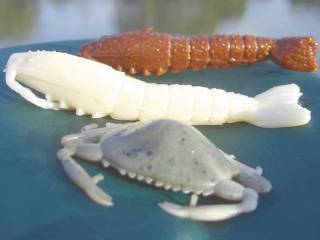 During my days helping customers find great lures and tackle for their fishing needs, I was often tasked with helping traveling fishermen find lures to use on their trips to saltwater destinations. While this may seem easy enough, each time I had to explain that an outdoors retailer located in the upper Midwest won’t carry very much—if any—saltwater tackle. The effective lure styles, manufacturers, and even color patterns that entice those powerful inshore species can’t be found far inland from the coast for a simple reason: they don’t sell where they’re not needed. This didn’t stop me from being able to help customers by introducing them to a handful of freshwater lures that would serve their purposes, after which I would then let them know what color patterns to look for once they reached their destinations.
During my days helping customers find great lures and tackle for their fishing needs, I was often tasked with helping traveling fishermen find lures to use on their trips to saltwater destinations. While this may seem easy enough, each time I had to explain that an outdoors retailer located in the upper Midwest won’t carry very much—if any—saltwater tackle. The effective lure styles, manufacturers, and even color patterns that entice those powerful inshore species can’t be found far inland from the coast for a simple reason: they don’t sell where they’re not needed. This didn’t stop me from being able to help customers by introducing them to a handful of freshwater lures that would serve their purposes, after which I would then let them know what color patterns to look for once they reached their destinations.
Open any outdoor retailer’s fishing catalog and you’ll see a vivid barrier between the saltwater and freshwater tackle, and you may even see two entirely separate catalogs. The reason for this is obvious: the prey items found in each type of water differ greatly. You won’t find nightcrawlers in saltwater and you won’t find crabs swimming around in freshwater. This is why the vast majority of freshwater soft plastics are made to resemble the drab, earthen colors worn by many prey items found there. Colors such as peanut butter and jelly, pumpkinseed, and black neon work wonders in lakes and ponds, where the water is often stained and prey items blend in to match. Lures made to resemble crawfish, leeches, minnows, and worms are also prevalent, as they perfectly mimic each of their real counterparts to the tee, which fool many species of fish into striking the lure.
For saltwater species, colors work a little differently. It’s popular to see both natural and brightly-colored patterns that often even consist of two contrasting colors. Color patterns such as new penny, for example, resemble shrimp very well, while patterns like electric chicken (neon green and pink) and clown (white and red) work wonders also. It is typically sunnier in tropical locations where saltwater species lurk, and the brightly colored lures stand out in the lighter water conditions, triggering a fish’s genetic impulse to strike. Tarpon, for example, can’t resist a topwater popper in the clown pattern, and redfish and trout love the combination of colors that make up many inshore plastic baits.
If you’re a warm-weather seeking fishermen this winter, then don’t waste your time scouring your local retailer for the tackle you’ll need. Take some time to learn what patterns work and either order them via catalog or through a website, or pick them up at a retailer near your hotel once you land. Research some of the patterns I’ve described—all of which have proven themselves many times over for thousands of fishermen throughout the years—and I’m sure you’ll find a handful of body styles and color patterns that will work for you.
For a wide selection of colors and styles for your saltwater needs, check out the saltwater tackle offered at Bass Pro Shops, MirrOLures ,D.O.A., Berkley, and the specialized baits made by Texas Tackle Factory.








